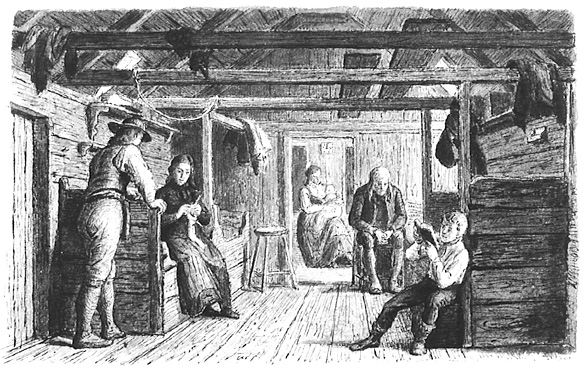Return to Text |
Biography (Contents) |
|---|

Kvöldvaka on an Icelandic farm. During the long months of winter darkness, the time between lighting the lamps in the evening and going to bed was known as kvöldvaka ("evening waking"). During this time the members of the farm household would gather in the commons room (baðstofa) and devote themselves to various indoor tasks, many of them connected with the wool industry. Ebenezer Henderson, who probably observed scenes like this during his residence in Iceland over the winter of 1814-15, writes:
A winter evening in an Icelandic family presents a scene in the highest degree interesting and pleasing. Between three and four o'clock the lamp is hung up in the badstofa, or principal apartment, which answers the double purpose of a bed-chamber and sitting-room, and all the members of the family take their station, with their work in their hands, on their respective beds, all of which face each other. The master and mistress, together with the children, or other relations, occupy the beds at the inner end of the room; the rest are filled by the servants.
The work is no sooner begun, than one of the family, selected on purpose, advances to a seat near the lamp, and commences the evening lecture [i.e., reading], which generally consists of some old saga, or such other histories as are to be obtained on the island. . . . The reader is frequently interrupted, either by the head, or some of the more intelligent members of the family, who make remarks on various parts of the story, and propose questions, with a view to exercise the ingenuity of the children and servants. In some houses the sagas are repeated by such as have got them by heart; and instances are not uncommon of itinerating historians, who gain a livelihood during the winter, by staying at different farms till they have exhausted their stock of literary knowledge. (IJR283-4)
In the illustration reproduced above, a man who has just entered from outside chats with a woman who sits on her bed knitting. In the background (in the baðstofuhús, the private apartment panelled off at one end of the baðstofa), a woman dandles a baby. To her right an older man is engaged in fulling (i.e., squeezing, compressing, and thus thickening) the wool of a mitten or sock. To his right a boy reads out loud from a book in order to entertain the others.
The sketch was made in 1861-2, probably from life, by the Danish portraitist August Schiøtt (1823-1895). (Since the sketch portrays a scene illuminated by natural light falling through the windows, it was probably made during the summer.)
In the second half of the eighteenth century Eggert Ólafsson wrote in his Ferðabók:
There is no gainsaying that the most intelligent and useful pastime engaged in by Icelanders is the time-honored tradition of reading the old sagas. . . . This usually takes place during the long hours of winter dusk. After the lamps have been lit, a boy (or perhaps a visitor) who is good at reading will be asked to read aloud. This saga-reading gives pleasure to the others while they work and also helps keep them awake. In order to make the pastime even more enjoyable, poets have — since the beginning of the fourteenth century — turned the sagas into verse, the so-called rímur, and these are chanted by men with a good voice. (1FEÓ31)
Source: National Museum of Iceland (Þjóðminjasafn Íslands).